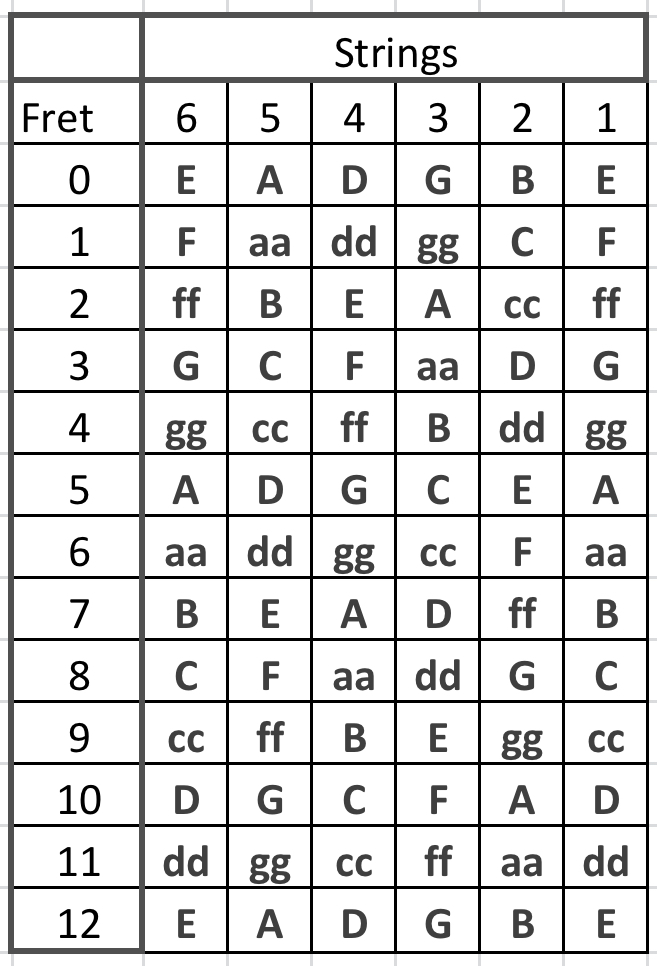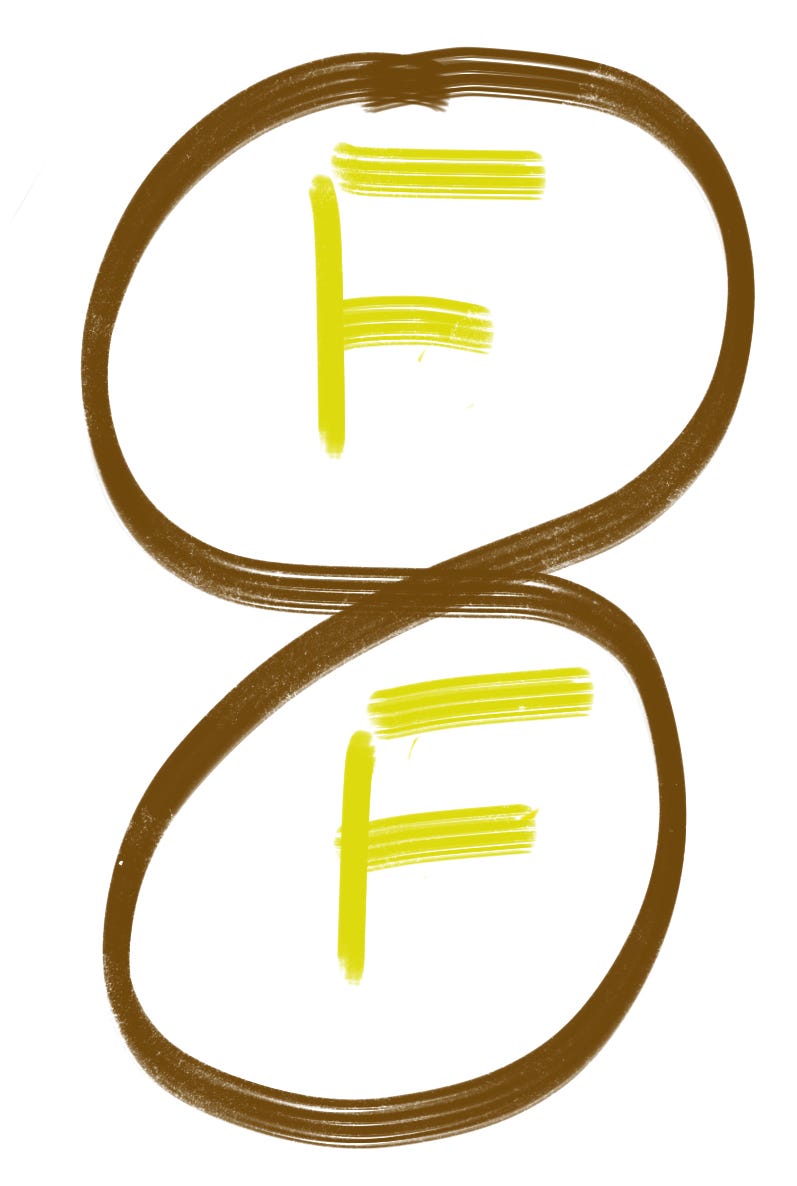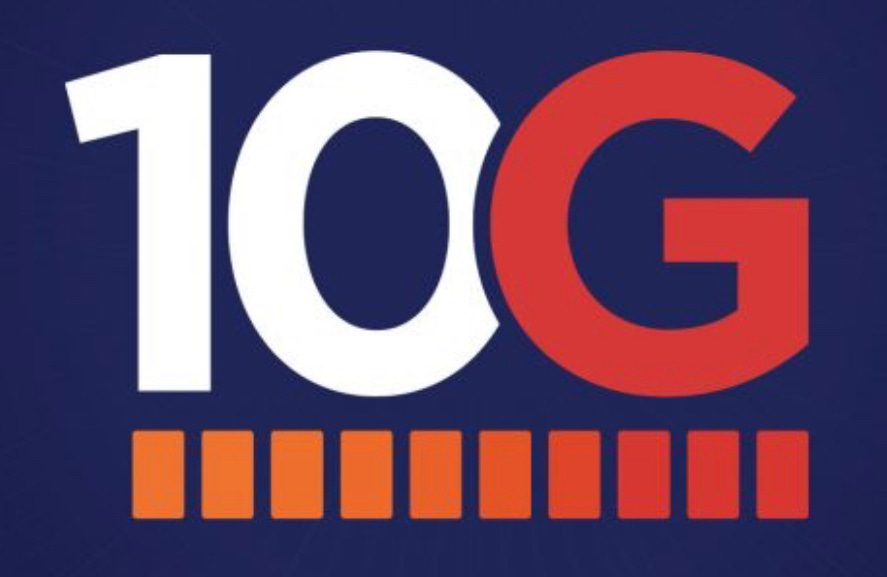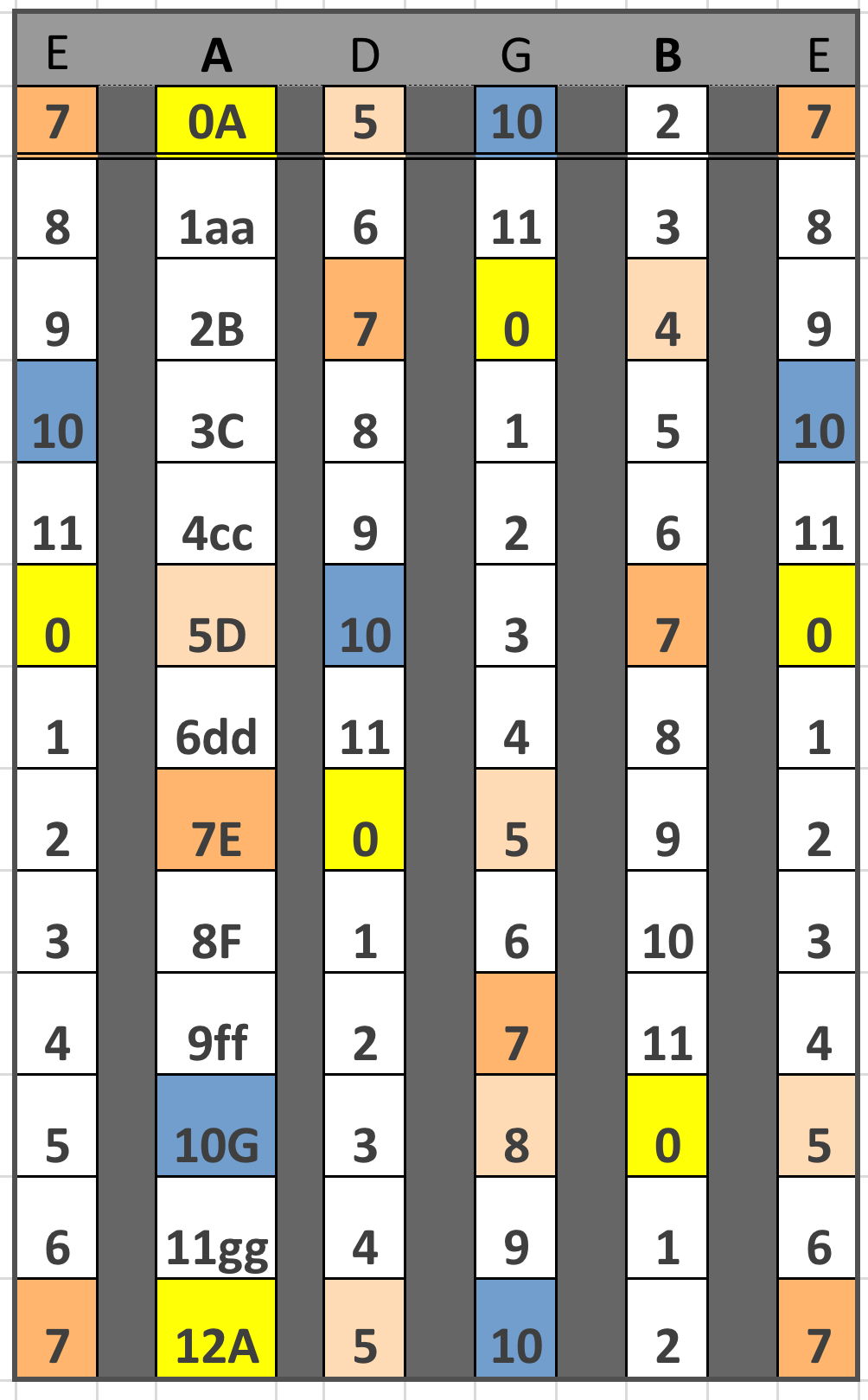Turn on your email images. It’s really required for this one. “Load Photo’s” and please subscribe!
Out of Time at the Vikid School of Music
As a casual guitar player for nearly 20 years I feel that it us an utter shame that I really don’t know the fretboard better. I still struggle on like 90% of the board and need to use tricks to “work out” notes most of the time.
The problem is that using “tricks” such octaves, shapes etc… is that they work in limited ways and more importantly, they take time.
Wasting Time is exactly what you don’t have when playing music. In music you have to be “in” time. Taking time, puts you out of time. That’s bad.
This article is primarily about the guitar but if you have any interest in Music, I do think there is much to gain, so please read on even if you’re not a guitarist.
The Challenge
So I have given myself a challenge, and that is to learn every note on the fretboard. So let’s go down the rabbit hole…
The Rabbit Hole
The Musical Alphabet is beyond repugnant. In case you don’t know it. Here it is:
A A# B C C# D D# E F G G# A
To save everyone a headache I have decided to spare you the flats, double flats and all that.
I find that sharps (and flats especially) are ugly as hell, so I devised a modified system that uses “lowercase letters doubled” to represent sharp figures.
So, for example A# = aa.
** I have nothing yet for flats but I am working on it.
This is a diagram of the Guitar fretboard, modified with the transformation:

Now I don’t know about you but this looks much better to me than the regular guitar fretboard.
But the prospects of learning this still makes my spine feel like jello!
Memory
The real problem with learning a system like this has to do with how our memory works. For most of us, it is sequential and the starting point matters immensely.
Take your ABC’s for example,
I can bet you can rattle them off in the forward direction (starting at A) but if I ask you to do them backwards starting at M, you are going to struggle.
Let’s make it simpler, can you start at O and go forwards?
How about the 7th letter after J?
All of a sudden you realize that you really don’t know the alphabet that well!
Now the way that Music works and especially the Guitar is that both these mediums are multidimensional. And you constantly have to be making calculations both in the forward, backwards and sideways directions.
Just look at the diagram above. It’s a Table of two dimensions. But it gets way, way worse than that!
On the guitar, you can be playing 1 to 6 strings at a time, so you need the relations between each of the strings and frets, don’t forget you can be bending them too, which adds the microtonal dimension.
Furthermore the “B” string is tuned to a 3rd rather than a 4th like all the other strings which destroys symmetry and easy patterns.
To add to this misery we have the Musical alphabet itself, as mentioned above but added here again for emphasis!

This is truly confusing as it actually modifies the ABC system that we know so well. Try singing your ABC’s with this crap mixed in.
Now finally there are at least two further complications that are worth mentioning.
One, music is almost never played Chromatically. (That means with all the notes). It’s played in combinations of 2nds, 3rds, 5ths, 7ths and higher, in their major, minor, dominant, diminished and other varieties. So you have to learn intervals and stacked intervals (for chords) to get something harmonious.
Secondly we get the boxes within boxes phenomenon.

For simplicity I just highlighted 3 boxes around dd / D# on the 8th fret. There are many many more such boxes! And in each harmonic context “dd” is different.
So simplicity is out the window. How are we going to get ourselves out of this mess and actually learn the fretboard?
I have scoured YouTube, I have bought a hell of a lot of courses, I have scraped the Internet and even delved deep into older books looking for a system.
What I found is that nothing is as easy as many authors promise. There is no magic bullet. There is no secret system that works, and you probably need to study music theory for a lifetime to get it all done.
Go Rote or get Broke.
However, there was this guy called Pareto and he came up with what’s now called the 80/20 principle. Which means that in most applications 20% efforts gets you 80% of the results. And the final 80% gets you 20% of the results. So I am thinking that perhaps something like that is the key.
Some kind of amazing conclusions comes out of this principle. Let’s say you know 10% of the fretboard. Well that’s not good enough.
With that knowledge you are probable getting 10% performance and you feel like a dufus.
Performance is linear to Knowledge.
Now let’s say you jack up your knowledge up by learning the “right” 20%. That is you learn just 10% more.
Now your getting 80% results. An increase in 70% performance! It’s no longer linear. You get exponential results.
Yet there is one more surprising conclusion.
You still feel like a dufus.
Why?… because of the 80/20 principle of course!
Because you only have 20% knowledge. This means that this feeling of inadequacy is going to be completely normal. So you can be a humble idiot and be proud of it. It shouldn’t stop you from achieving your immediate goals.
80/20 Vikid Style
So I have devised my own system. I will assume that you are not a complete novice and that you know the open strings. In case you don’t, we have you covered. Learn this:
E(A)DG(B)E
EDGE between A & Bas in:
E (A) DG (B) E
Is a good mnemonic I found on YouTube from this guy:
An interesting video. Just watch just the first few minutes, the rest isn’t needed.
Then we have “Guitar Math”
A aa B C cc D dd E F ff G gg A
0 1 2 3 4 5 6 7 8 9 10 11 12
I won’t waste your time explaining the whole system. Just watch the video and memorize the letter number relationship. We start at A because it is a more natural place than the traditional C and because it makes more sense with the geometry of the guitar.
Some help with memorization:
You should never forget 8 is F after looking at this:

and C is pretty easy to remember too:

If you can C the naughty suggestion in the picture it might help 😄.
Now I think of having “10 G’s in my Pocket” as a Gansta! Or this logo is quite memorable:

11gg - is memorable in itself, so is 9ff
The Phrase B2B normally means “Business 2 Business” or perhaps you like Shakespeare, “2 B or not 2 B”!

Try and forget that, I dare you!
This is a picture of a 5D hypercube:

Hope that helps, 5-D was a hard one but this should be good for 6

Let’s go to Florida for some help:

Highway a1a, which looks like the colloquial name for Richard. Hard to forget that!

“E 7 teen” - was a famous band when I was growing up. That may or may not work for you. You get the idea and can make your own as you see fit.
Now we’re going to modify the fret-board diagram with this information in mind.
For a start, we get this:

Here, I have replaced the string letters with the “Guitar Math” numbers and highlighted some important rows.
But I still feel it isn’t good enough. Can we do better? Yes, we can…

Now that does look a lot better!
I have formatted the diagram a little adding some color, simulating strings and the dark fret-board behind them.
First thing to notice is the A-string gives us our fret numbers AND note names,
so we can eliminate the useless column repressing the Fret Numbers.
Very convenient.
I’ve add the letters directly to the A-string, so…
It’s best to memorize that first - the whole thing!
And that’s the worst this system can be.
You learn one out of 5 strings. Surely that isn’t so difficult?
There is something beautiful about using numbers here because
I always felt that all the notes are “equal”.
When we use accents. Most people curl at the thought of learning where all the A#’s are, but learning where all the 1’s are seems almost completely natural. Numbers equalize the notes. 1 is not less important that 3.
My next suggestion is to learn the B-string. B is only 2 away from A. So it’s like A, just shifted by 2, forwards. Example:
B-String: 10th Fret + 2 = 12 = A
Then learn the G-string. That’s 2 in reverse. Example:
10th fret - 2 = 8 (F)
you have 3 out of 5 strings done!
After G, you go for the D-string (5) and finally E-string (7), which you probably know anyway if you ever played the guitar.
Pretty much reverse of what every guitar teacher who ever lived has ever said!
This is The Vikid Truth.
Second thing we are going to do is learn the “common numbers” on each string. This way we can start anywhere we like.
Start by learning all the A (0) positions on each string.
Then in order:
2, 3, 5, 7, 8 & 10, which is:
B, C, D, E, F & G
followed by 11, 4, 6, 9 & 1
What I mean by this is that you want to pick A (0) for example and then play all the A’s on each string.
Do it to a metronome.
Do the strings in forward and reverse orders, then randomly. Just learn the numbers and their locations.
Like “we find a 0 on the 10th fret of the 2 string”.
Were going to avoid thinking too much about patterns as we want random access memory.
Do it in the dark or with your eyes closed to build muscle memory.
Once you’ve nailed it move on to another number / letter.
Another option you have is to find the A’s and after each one, play B C. So your moving around with A B C repeating on each string. Get creative. You get the idea.
Unfortunately we have reached the limits of email length!
So Please look out for part 2, in which we will learn about going horizontally…
and that’s,

The Vikid School of Music



